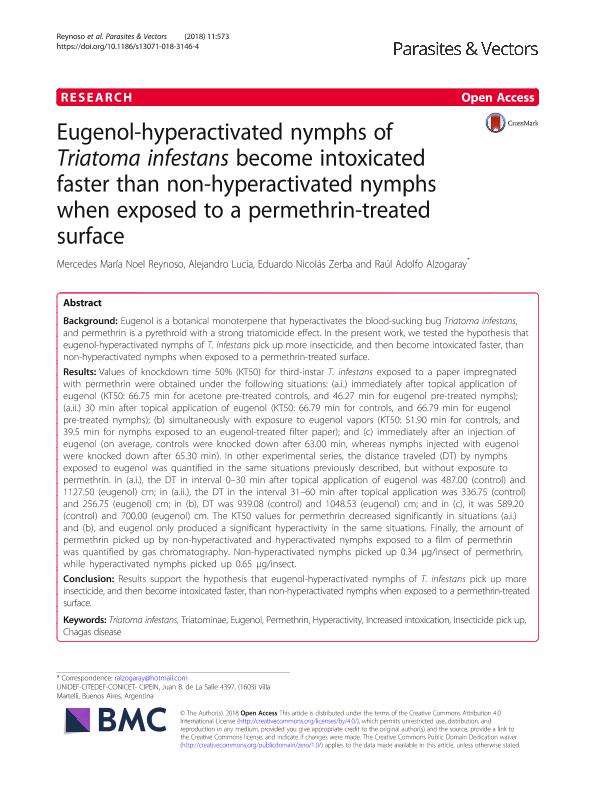Mostrar el registro sencillo del ítem
dc.contributor.author
Reynoso, Mercedes María Noel

dc.contributor.author
Lucia, Alejandro

dc.contributor.author
Zerba, Eduardo Nicolás

dc.contributor.author
Alzogaray, Raúl Adolfo

dc.date.available
2020-01-16T18:42:06Z
dc.date.issued
2018-11
dc.identifier.citation
Reynoso, Mercedes María Noel; Lucia, Alejandro; Zerba, Eduardo Nicolás; Alzogaray, Raúl Adolfo; Eugenol-hyperactivated nymphs of Triatoma infestans become intoxicated faster than non-hyperactivated nymphs when exposed to a permethrin-treated surface; BioMed Central; Parasites and Vectors; 11; 1; 11-2018; 573-581
dc.identifier.issn
1756-3305
dc.identifier.uri
http://hdl.handle.net/11336/94920
dc.description.abstract
Background: Eugenol is a botanical monoterpene that hyperactivates the blood-sucking bug Triatoma infestans, and permethrin is a pyrethroid with a strong triatomicide effect. In the present work, we tested the hypothesis that eugenol-hyperactivated nymphs of T. infestans pick up more insecticide, and then become intoxicated faster, than non-hyperactivated nymphs when exposed to a permethrin-treated surface. Results: Values of knockdown time 50% (KT50) for third-instar T. infestans exposed to a paper impregnated with permethrin were obtained under the following situations: (a.i.) immediately after topical application of eugenol (KT50: 66.75 min for acetone pre-treated controls, and 46.27 min for eugenol pre-treated nymphs); (a.ii.) 30 min after topical application of eugenol (KT50: 66.79 min for controls, and 66.79 min for eugenol pre-treated nymphs); (b) simultaneously with exposure to eugenol vapors (KT50: 51.90 min for controls, and 39.5 min for nymphs exposed to an eugenol-treated filter paper); and (c) immediately after an injection of eugenol (on average, controls were knocked down after 63.00 min, whereas nymphs injected with eugenol were knocked down after 65.30 min). In other experimental series, the distance traveled (DT) by nymphs exposed to eugenol was quantified in the same situations previously described, but without exposure to permethrin. In (a.i.), the DT in interval 0-30 min after topical application of eugenol was 487.00 (control) and 1127.50 (eugenol) cm; in (a.ii.), the DT in the interval 31-60 min after topical application was 336.75 (control) and 256.75 (eugenol) cm; in (b), DT was 939.08 (control) and 1048.53 (eugenol) cm; and in (c), it was 589.20 (control) and 700.00 (eugenol) cm. The KT50 values for permethrin decreased significantly in situations (a.i.) and (b), and eugenol only produced a significant hyperactivity in the same situations. Finally, the amount of permethrin picked up by non-hyperactivated and hyperactivated nymphs exposed to a film of permethrin was quantified by gas chromatography. Non-hyperactivated nymphs picked up 0.34 μg/insect of permethrin, while hyperactivated nymphs picked up 0.65 μg/insect. Conclusion: Results support the hypothesis that eugenol-hyperactivated nymphs of T. infestans pick up more insecticide, and then become intoxicated faster, than non-hyperactivated nymphs when exposed to a permethrin-treated surface.
dc.format
application/pdf
dc.language.iso
eng
dc.publisher
BioMed Central

dc.rights
info:eu-repo/semantics/openAccess
dc.rights.uri
https://creativecommons.org/licenses/by/2.5/ar/
dc.subject
CHAGAS DISEASE
dc.subject
EUGENOL
dc.subject
HYPERACTIVITY
dc.subject
INCREASED INTOXICATION
dc.subject
INSECTICIDE PICK UP
dc.subject
PERMETHRIN
dc.subject
TRIATOMA INFESTANS
dc.subject
TRIATOMINAE
dc.subject.classification
Zoología, Ornitología, Entomología, Etología

dc.subject.classification
Ciencias Biológicas

dc.subject.classification
CIENCIAS NATURALES Y EXACTAS

dc.title
Eugenol-hyperactivated nymphs of Triatoma infestans become intoxicated faster than non-hyperactivated nymphs when exposed to a permethrin-treated surface
dc.type
info:eu-repo/semantics/article
dc.type
info:ar-repo/semantics/artículo
dc.type
info:eu-repo/semantics/publishedVersion
dc.date.updated
2019-10-23T14:35:37Z
dc.journal.volume
11
dc.journal.number
1
dc.journal.pagination
573-581
dc.journal.pais
Reino Unido

dc.journal.ciudad
Londres
dc.description.fil
Fil: Reynoso, Mercedes María Noel. UNIDEF-CITEDEF-CONICET- CIPEIN; Argentina
dc.description.fil
Fil: Lucia, Alejandro. UNIDEF-CITEDEF-CONICET- CIPEIN; Argentina
dc.description.fil
Fil: Zerba, Eduardo Nicolás. UNIDEF-CITEDEF-CONICET- CIPEIN; Argentina
dc.description.fil
Fil: Alzogaray, Raúl Adolfo. UNIDEF-CITEDEF-CONICET- CIPEIN; Argentina
dc.journal.title
Parasites and Vectors

dc.relation.alternativeid
info:eu-repo/semantics/altIdentifier/url/https://parasitesandvectors.biomedcentral.com/articles/10.1186/s13071-018-3146-4
dc.relation.alternativeid
info:eu-repo/semantics/altIdentifier/doi/http://dx.doi.org/10.1186/s13071-018-3146-4
Archivos asociados
